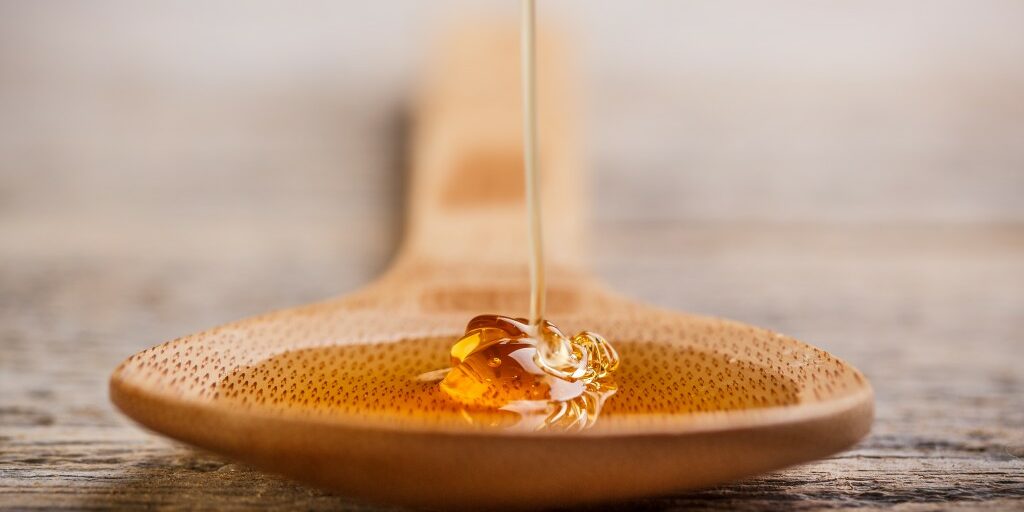Ever since a few articles were published back in 2010 saying that Agave Nectar is no better than High Fructose Corn Syrup, I’ve had quite a few concerned emails from readers who were surprised that I recommended this horrendous sweetener in some of my recipes. I like Agave nectar (but only certain brands), but it is a sweetener, and it IS high in fructose. This means that it will be stored as fat if too much is consumed. I treat all sweeteners as “sugar”, with the exception of date sugar and Molasses. Both of these sweeteners contain nutrients, and so cannot be called “empty calories”. But, here’s why I would consume good quality Agave* over vile High Fructose Corn Syrup (HFCS):
*When I talk about Agave Nectar in this post, I am referring to one that is USDA organic, and Fair Trade.
Let’s first look at what high fructose corn syrup is made of: It is made from genetically modified corn that’s grown using synthetic chemicals. I believe these farming and refining practices are unsustainable and are detrimental to our soils, water, and air.
Agave nectar is high in fructose, but so are many foods that we eat. This is Dr. Mercola’s main beef with agave nectar. And while it is true that agave is high in fructose, fructose it is the most common form of sugar in all fruits. Fructose is a natural form of carbohydrate, and for thousands of years, it has been an important source of energy for the body. But a tiny bit goes a very long way, and the trouble we’ve got ourselves into over the last two decades is that sweeteners are added to practically every processed food on the market. We are getting way more than nature intended, which is why we are getting sick and obese. And BTW, nature intended that we get our fructose from fruits and veggies, right?
However, Fructose & High Fructose Corn Syrup are not the same!
There is no comparison between a natural form of fructose, such as in fruit or from agave, and the chemically-processed, pesticide-laden, genetically-modified High Fructose Corn Syrup (HFCS). The fructose in agave is a slow release form of sugar. This means that, in comparison to HFCS, which spikes blood sugar levels, agave does not cause the stimulation insulin secretion that leads to harmful rises in blood sugar. What is more, the enzymatic processing of agave is very different from the process of High-Fructose Corn Syrup, which fabricates fructose out of the glucose made from the milled starch of corn. For HighFructose Corn Syrup, glucose chains in the starch are broken down into long chain lengths of glucose molecules. These long chains are less sweet, but offer easier viscosity and functionality than raw glucose. Producers of High Fructose Corn Syrup are looking for this better viscosity and adaptability, as it allows them to add it, unnoticed, to virtually any substance. To do this, they dry the corn and mix it with water and sulfar dioxide.
From there, the starches are separated from the kernel, fiber and protein. The separated starch slurry is then processed at very high temperatures, mixed with acid, neutralized, and then treated with an enzyme to create a 42% fructose and 55% glucose syrup. It is these strong acids and caustic chemical additives that are believed to be related to mercury contamination in HFCS. Moreover, most HFCS is made from genetically-modified corn, adding yet another contaminant into the processing mix.
Organic agave nectar’s processing could not be further related from this aforementioned processing of High-Fructose Corn Syrup. Agave is processed through either the use of natural enzymes, or through the use of thermal hydrolysis. These processes are essentially used only to evaporate the nectar from the liquid juice that is extracted from the plant. The processing of agave is done in the exact same way in which bees make honey, whether through a natural enzyme in the bee’s stomach, or when they fan their wings to evaporate the natural water out of the sweet liquid before capping into the honey comb.
In conclusion, if you are forced to choose between HFCS and Agave Nectar, go for the latter, and a brand I highly recommend is Madhava.
But let me be very clear: You are better off without either in your day-to-day diet. Any kind of sugar will spike your blood sugar and should not be used by anyone with pre-diabetes, diabetes, or any kind of insulin resistance. You are way better off getting your sugar from fruits. Even if you are still concerned about getting too much sugar from your fruit, keep in mind that the sugars in say berries, are slowly released because of the soluble fiber that is also in the fruit. When sugar is slow-release, it will not spike your blood sugar in the same way that a HFCS, Agave Nectar, or a slice of white bread will.
And, my final thought in this diatribe is that if you forego all of these sticky sweeteners for a couple of weeks, a little fruit will begin to taste very, very sweet. I recommend going cold turkey for 2 weeks, and then you will be able to enjoy the sweetness that nature intended us to eat in the first place.




